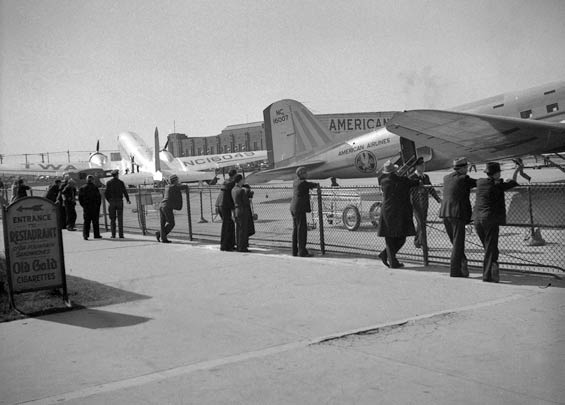|
This airplane, S/N 1549 was manufactured under ATC# 607 August 20, 1936 by the Douglas Aircraft Co., Santa Monica, CA. It was the 12th production DC-3. It left the factory with two Wright SGR-1820-G-2 engines of 850HP each (right engine S/N 24025; left S/N 23539). It was a seventeen-place, low wing monoplane. It sold on August 21, 1936 to American Airlines, Inc. of Chicago, IL.
By extrapolation to other traffic recorded nearby in the Register, NC16007 landed at Tucson sometime between September 1st and September 6, 1936. The pilot was Dave Doty and he carried two passengers, Johnnie Lee McKinney and Dorothy Weaver. There was no indication in the Register if a copilot was aboard or if one of the people listed as passenger was a copilot. Neither did Doty identify his home base, origin, destination or dates of arrival or departure. Chances are, though, this was a brand new airplane on its way from Santa Monica to the American Airlines stable.
Below are two photographs of NC16007 as it was operated by American Airlines as the "Flagship California." They were taken at Chicago Municipal Airport ca. May 6, 1937 (Chicago Municipal became Chicago Midway in 1949). These sharp photographs were made by W.A. Traver, Sr., whose grandson, Al, shares them with us.
Douglas DST, Chicago, IL, May 6, 1937 (Source: W.A. Traver, Sr.)
 |
The sign at left, above, advertises the entrance to the restaurant, which sold sandwiches and had a soda fountain. The other Douglas is NC16049, operated by TWA. Bob Woodline states, "The TWA DC-2 in the background (NC16049) was sold to Pan Am on 25 May 1937, so the photo had to be taken before that date."
Below, a full profile of NC16007. Visible is a company pennant displayed from the copilot's window. This was a ground ritual of all American Airlines copilots. A picture of one of the pennants flown from planes captained by Register pilot Hap Russell is exhibited in the American Airlines section of his Photograph & Document Collection. Take a few minutes to look around Russell's collection to learn of the life of an American Airlines pilot.
Douglas DST, Chicago, IL, May 6, 1937 (Source: W.A. Traver, Sr.)
 |
At the far right center of this photograph appears the front end of a Curtiss Condor, which was also used by American Airlines (the type was flown by Hap Russell) before the Douglas DC-2 and DC-3 made them obsolete. There is a wheelbarrow and workmen visible, who appear to be working on the margin of the apron. Chicago Municipal was served by at least three airlines: American, TWA and Braniff, whose baggage cart is visible in the foreground.
Other than the basic factory technical facts for NC16007, the NASM record begins in 1938, so there are almost 1.5 years unrecorded. The early history, as well as physical descriptions of how the airplane evolved from the DC-2 airframe, and how its model designations changed as newer and more powerful engines were installed, is covered in THIS REFERENCE, Volume 7, pages 29-32.
From the NASM record, around May 18, 1937 it had its deicer equipment removed and a radio compass installed. Note, on the photo above, the lack of deice boots that would appear as black bands on the leading edges of the wings and the horizontal and vertical stabilizers. This suggests the date of the photographs may be off a little.
On February 15, 1938 16007 was licensed to carry 31 people, including the pilot and copilot. The NASM record specified that at night 14 passengers could be carried; during the day, twenty-eight. It went through at least four model designation changes between 1938 and 1940. It was a very busy airplane during the mid- to late 1930s. As of September 29, 1940 it had accumulated 12,658:14 flight hours. By September 22, 1941 it had accumulated 14,795:26. Flying any airplane over 2,000 flight hours in a year, for that era, was a substantial mechanical, as well as logistical, challenge.
As WWII spooled up, on August 25, 1942, NC16007 was sold to the Defense Supplies Corp. On March 23, 1943 it was sold to the War Department, its CAA license was cancelled and it became C-49E 42-56094 and was described as, “Being operated under Army insignia”.
On November 2, 1944 it was sold back to American Airlines, Inc., for $31,506.44. It had two Wright GR-1820-85 engines installed and converted to a DC-3 G-102 under ATC# 618 (REFERENCE, Volume 7, pages 69-77). Aircraft total flight time was 24,650:34. Do the math and you’ll see that the Army used this airplane well.
American sold the airplane to L.B.S. Aircraft Corp. of Camp Hill, PA on May 18, 1949. They removed the G-102 engines and installed Wright G-202A ingines and overhauled the aircraft. The type was then designated DC-3 G202A.
L.B.S. sold the NC16007 on August 19, 1949 to Sociedad Anonima Nacional de Transportes Aereos, Quito, Ecuador. The U.S. license was canceled by the CAA on August 25, 1949 and the airplane was exported to Ecuador as registration HC-SMB. Ultimately, it ended up with several Bolivian airlines. The first airline was Lloyd Aero Boliviano, the second was CADET (Cooperativa Aerea de Transportes LTDA. It was reported that the airplane was later sold to CAT (Carga Aereo Transpotada). A photograph of the airplane taken December 27, 1972, then registered CP-572 in CADET livery, is at the link. It is named "Lupita" in the photograph.
According to Joe Baugher’s site, 42-56094/NC16007/HC-SMB, etc. was withdrawn from use as of 1977. Final fate unknown. Does anyone KNOW?
---o0o---
Dossier 3.1.41
UPLOADED: 12/29/07 REVISED: 04/14/12
|



